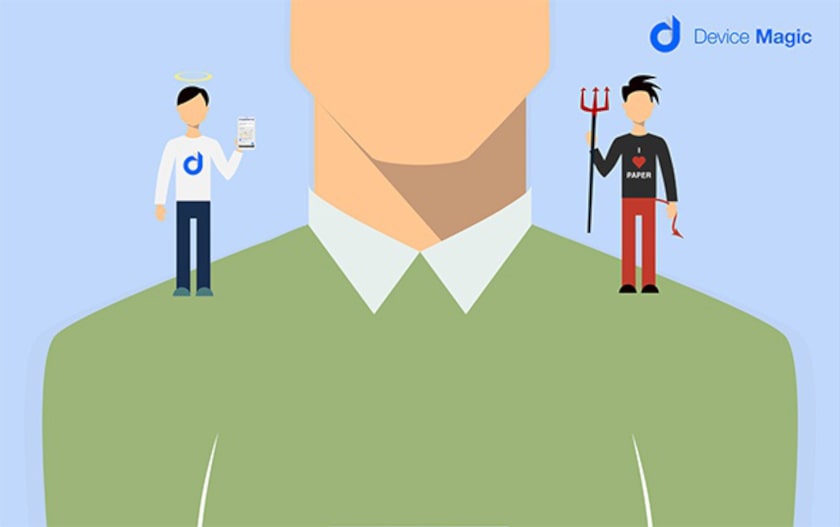8 Lies You’ve Been Telling Yourself About Paperwork

We get it, you’re used to using paper. And you probably think it’s not actually causing that much of a problem for your business. We hate to break it to you, but it’s all been a lie.
These are the lies you’ve been telling yourself and why they just aren’t true.
1. LIE: Paper doesn’t cost that much.
As much as 3% of a company’s revenue is spent on paper, printing, filing and the costs to store and maintain files of information. Do you really want to give away that much of your company’s revenue?
The cost of paper isn’t limited to financial. The hours being spent to create and process paperwork can add up quickly, between printing forms out, having the correct person complete the information before scanning or re-entering it into a database, then finally filing the paper copy.
By using a digital system instead processes can be streamlined. Forms are completed once and sent directly to all of the places you need them to be, which boosts productivity and ultimately saves money.
2. LIE: We don’t use that much paper.
You’re probably using more paper than you realize. The average office worker uses 10,000 sheets of paper each year, plus an organization’s paper usage grows about 22% per year, which doubles costs every 3.3 years.
Those resources could be allocated to advancing and improving your business instead of being wasted on paper.
3. LIE: The field crew isn’t wasting time completing their forms.
Field crews save around 11 hours per week by using mobile forms instead of paper. When employees in the field can focus on the task at hand instead of worrying about completing their paperwork or trying to find a printer or scanner to send it back to the office they will be more productive.
When productivity is improved, the whole business benefits. Jobs are completed more quickly, which leads to the ability to take on additional projects.
4. LIE: The paperwork we receive is accurate and complete.
Staff in the office needs to be able to use information as soon as it comes in. This means that forms need to be completed thoroughly with no answers missing, as well as being legible. But paperwork typically has 50% more errors than mobile forms.
When the information included on paperwork isn’t correct, time is spent re-filling out the forms or hunting down the answers – time that should be spend completing other tasks.
5. LIE: Needing to re-enter data doesn’t take much time.
Needing to re-enter the data from paper forms into your database may not seem like a big deal, but it’s wasting more time than you realize. You could save an average of 10 administrative hours per week by eliminating data entry. That time then becomes available for more important tasks.
You also remove the potential for human error when inputting data from paperwork into another system when forms are digital to begin with.
6. LIE: We don’t have to wait too long for data and paperwork to be delivered.
Paperwork is received 25% slower than mobile forms and real-time data capture results in getting data 3-5 days faster than you would normally. When you receive data from workers offsite sooner you can use that information to make better decisions and keep workflows moving forward.
For example, if you have a team on a remote jobsite, managers will need to know what work has been completed each day. That way they can relay updates to clients and other stakeholders, as well as organize things like ordering materials and scheduling outside vendors. Without this information, your project can become delayed quickly.
7. LIE: It’s too hard to switch to a new process.
In a recent survey, over 75% of businesses said it was easy or very easy to get started with Device Magic mobile forms. Making the switch to a paperless process can feel overwhelming, but it doesn’t have to be when you use the right tools and follow a plan.
Technology has made it faster and easier to get and share information, and going paperless at work benefits your company with increased productivity and fewer delays.
Try these steps to get started:
- Get everyone on the same page about going paperless
- Create an implementation plan and set clear goals
- Invest in the right technology
- Provide training on your new technology and process
- Don’t give in to old habits. Stay digital moving forward
8. LIE: We need to have a paper copy of everything.
Having a paper copy of documents or relying solely on paper is less secure than using other storage options. What if the paperwork is lost or damaged? What if there is a fire or flood?
Large organizations lose one document every 12 seconds. If you don’t have a backup of that document you’ll be in big trouble.
Cloud storage solutions keep documents safe and securely stored. If you’re worried about sensitive data, there are plenty of options available to keep this information secure. It will definitely be safer than sensitive information living in a filing cabinet.
Ready to stop lying to yourself? Eliminate paperwork with mobile forms software.